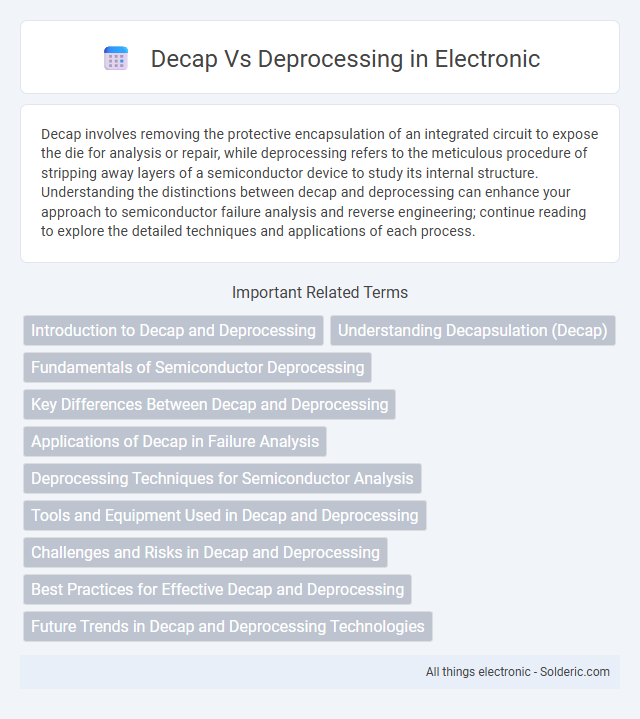Decap involves removing the protective encapsulation of an integrated circuit to expose the die for analysis or repair, while deprocessing refers to the meticulous procedure of stripping away layers of a semiconductor device to study its internal structure. Understanding the distinctions between decap and deprocessing can enhance your approach to semiconductor failure analysis and reverse engineering; continue reading to explore the detailed techniques and applications of each process.
Comparison Table
| Feature | Decap | Deprocessing |
|---|---|---|
| Definition | Removal of the package lid to expose the silicon die. | Complete removal of all packaging materials to isolate the die. |
| Purpose | Visual inspection or testing of silicon die. | Full access to the die for detailed failure analysis or modification. |
| Process Complexity | Less complex, focused on top layer removal. | More complex, involves multiple steps including chemical etching. |
| Time Required | Shorter duration (minutes to hours). | Longer duration (hours to days). |
| Material Removed | Package lid or mold compound. | All packaging including substrate, mold compound, and adhesives. |
| Risk Level | Lower risk of die damage. | Higher risk due to intensive chemical and mechanical processes. |
| Applications | Failure analysis, quality control, sample preparation. | In-depth failure analysis, reverse engineering, die modification. |
Introduction to Decap and Deprocessing
Decap, short for decapsulation, involves removing the outer packaging of an integrated circuit to expose the internal semiconductor die for inspection or analysis. Deprocessing refers to the step-by-step removal of material layers on a microchip, such as passivation, metal, and dielectric layers, to access and study specific structures or circuits. Understanding both decap and deprocessing is essential for failure analysis, reverse engineering, and ensuring the quality of semiconductor devices.
Understanding Decapsulation (Decap)
Decapsulation (Decap) is a precise technique used to remove the protective package or encapsulation material from semiconductor devices to expose the internal die for inspection or failure analysis. It involves chemical etching or mechanical milling methods to access critical components without damaging the underlying structures. Understanding decapsulation is essential for identifying defects, verifying manufacturing quality, and enabling detailed microelectronic analysis.
Fundamentals of Semiconductor Deprocessing
Decap and deprocessing are essential techniques used in semiconductor failure analysis and reverse engineering, where decapsulation (decap) involves removing the package encapsulating the silicon die to expose the chip surface. Semiconductor deprocessing extends beyond decap by sequentially etching and polishing multiple layers of the integrated circuit, revealing its internal structures from metal interconnects to transistor-level details. Mastery of chemical etchants, plasma etching, and mechanical polishing is fundamental to successful deprocessing, enabling defect localization, process verification, and intellectual property extraction.
Key Differences Between Decap and Deprocessing
Decap involves removing the outer protective packaging of a semiconductor device to expose the die for inspection or failure analysis, whereas deprocessing refers to the more detailed removal of multiple layers of the semiconductor device to analyze or modify internal structures. Decap is typically a quicker, less invasive procedure focused on accessing the die surface, while deprocessing requires precision etching or grinding to reveal internal features like interconnects and transistors. Understanding these key differences is crucial for semiconductor failure analysis, quality control, and reverse engineering processes.
Applications of Decap in Failure Analysis
Decapsulation (Decap) is a critical technique in failure analysis used to expose the internal semiconductor die for detailed inspection and testing, enabling identification of defects such as delamination, cracking, or metal migration. Its applications include root cause analysis in integrated circuits, verification of packaging integrity, and detection of counterfeit chips by revealing die authenticity. Decap facilitates advanced microscopy and electrical probing, essential for diagnosing issues in microelectronics manufacturing and improving product reliability.
Deprocessing Techniques for Semiconductor Analysis
Deprocessing techniques for semiconductor analysis involve the systematic removal of packaging and layers to reveal internal structures for inspection and failure analysis. Common methods include chemical etching, plasma etching, and mechanical polishing, each targeting specific materials like epoxy molding compounds and dielectrics to expose the die and interconnects. These precise approaches enable detailed examination of integrated circuits, facilitating defect identification and reverse engineering in semiconductor devices.
Tools and Equipment Used in Decap and Deprocessing
Decap and deprocessing utilize specialized tools and equipment designed for precise semiconductor handling; decap typically requires chemical strippers, plasma ashing systems, or mechanical grinders to remove packaging materials from integrated circuits. Deprocessing involves advanced microscopy, precise etching tools such as wet chemical baths or focused ion beam (FIB) systems, and cross-sectioning devices to analyze internal chip structures. Understanding these instruments enables you to select appropriate methods for chip failure analysis, reverse engineering, or quality inspection tasks.
Challenges and Risks in Decap and Deprocessing
Decap and deprocessing involve removing packaging materials to access semiconductor chips, presenting significant challenges such as potential damage to delicate circuits and contamination risks from chemical agents used during the process. Precise control over temperature and mechanical stress is critical to prevent microfractures or delamination, which can compromise data integrity and device functionality. Furthermore, improper handling during decapsulation can lead to unreliable test results, affecting failure analysis and quality assurance in semiconductor manufacturing.
Best Practices for Effective Decap and Deprocessing
Effective decapsulation (decap) and deprocessing require precise control of chemical and mechanical methods to avoid damaging sensitive semiconductor structures. Best practices include selecting appropriate solvents and etchants tailored to the package material, maintaining proper temperature and time parameters, and using microscopy to monitor progress closely. Ensuring thorough cleaning after decap improves your ability to conduct accurate failure analysis or reverse engineering without compromising the integrity of the die.
Future Trends in Decap and Deprocessing Technologies
Future trends in decap and deprocessing technologies emphasize increased automation and precision to enhance failure analysis and semiconductor inspection. Advanced imaging techniques combined with AI-driven data interpretation are transforming your ability to detect microscopic defects without damaging components. Innovations aim to reduce processing time while improving yield and reliability in semiconductor manufacturing.
Decap vs Deprocessing Infographic

 solderic.com
solderic.com